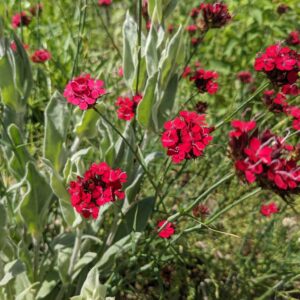Perennials & Biennials
Showing 137–144 of 511 results
-
Delphinium tricorne Dwarf larkspur, Spring larkspur Z 4-8
Spring ephemeral of blue delphinium elf-cap spikes. Substitute these for tulips, a favorite food of deer and rabbits
OUT OF STOCK – Available to order in Spring only
Spring ephemeral of blue delphinium elf-cap spikes. Substitute these for tulips, a favorite food of deer and rabbits
Size: 18-24” – 6-9”
Care: sun to shade in moist well-drained to moist soil
Native: Pennsylvania to Iowa, south to Alabama and Oklahoma and states in between
Wildlife Value: food for hummingbirds and butterflies; deer & rabbit resistant.Collected by André Michaux c. 1800. Cherokee used this for heart ailments and reported that it makes cows intoxicated and they die. The name tricorne comes from the 3-cornered shape of its seeds, like the shape of colonial hats with brims turned up on three sides. This is breathtakingly beautiful but slow to grow. It is also an ephemeral and dies back after going to seed so mark it or have a good memory where it is so you don’t dig into it planting something else. It comes back in spring.
-
Dendranthema weyrichii syn. Chrysanthemum weyrichii Alpine daisy Z 4-8
Pink or white daisies all summer and fall
OUT OF STOCK
Pink or white daisies all summer and fall. One of the best for groundcover, front of border or rock garden plant.
Size: 6” x 18”
Care: sun in well-drained soil. Drought tolerant.
Native: East Asia & eastern RussiaCollected before 1891
-
Desmanthus illinoensis Prairie mimosa, Illinois bundleflower Z 5-9
This legume bears round heads of frilly white flowers that turn to interesting spherical seed pods persisting all winter.
This legume bears round heads of frilly white flowers that turn to interesting spherical seed pods persisting all winter.
Size: 4’ x 3’
Care: sun in moist well-drained to dry soil. Looks like a shrub but is a perennial.
Native: Ohio to Florida and west to New Mexico and all states in between
Wildlife Value: Seeds are food for birds including the Ring-Necked Pheasant, Bobwhite Quail, and Greater Prairie Chicken.Desmanthus is Greek meaning “bundle flower” because the bunched flowers looked like a bundle. Pawnee, Sioux, Omaha & Ponca children used seed pods with dried seeds as rattles. Pawnees relieved itching with the boiled leaves. Sioux ate roasted seeds. Collected by French planthunter André Michaux (1746-1803) who spent 11 years in the US collecting plants
-
Dianthus amurensis syn Dianthus chinensis Amur Pink Z 3-8
Five jagged-edged petals on its plum-purple blossoms, not pink, as are all other “pinks, the common name for Dianthus. It also flowers later and longer than most other Dianthus, flowering most of the summer. Its uniform purple stamens meld into the flower’s view but a thin, deep purple line encircles the center.
Five jagged-edged petals on its plum-purple blossoms, not pink, as are all other “pinks, the common name for Dianthus. It also flowers later and longer than most other Dianthus, flowering most of the summer. Its uniform purple stamens meld into the flower’s view but a thin, deep purple line encircles the center.
Size: 12" x 12"
Care: Sun in well-drained soil
Native: Amur River regionAmurensis means from the Amur River (flows between the boundaries of China and Russia.)
Re-named, separated from Dianthus chinensis, by French nurseryman and hybridizer Henri Antoine Jacques (1782–1866), best known for his creation of the Bourbon rose, in 1861 in Journal de la Société Impériale et Centrale d’Horticulture 7: 625. 1861 -
Dianthus carthusianorum Clusterhead PinkDianthus carthusianorum Carthusian pink, Clusterhead pink Z 5-9
Deep reddish pink flowers atop wiry stems from June until frost
Rosy carmine pink flowers atop wiry stems from June until frost
Size: 16" x 8"
Care: sun in moist well-drained soil.
Native: Central and southern Europe
Wildlife Value: attracts hummingbirds. Deer resistant.The common name “pink” is from “pinct” referring to the jagged edge of the petals. The word “pink” referring to the color, came from the fact that most of the Dianthus are pink. This species may have come into gardens with the Carthusian monks in the 1100’s.
-
Dianthus cruentus Blood pink Z 5-9
Small but eye-catching carmine flowers held high on a leafless stem above basal foliage. Blooms in late spring-early summer
Small but eye-catching carmine flowers held high on a leafless stem above basal foliage. Blooms in late spring-early summer
Size: 2-3’ x 6-9”
Care: sun in moist well-drained soil
Native: Balkans
Wildlife Value: Attracts bees & butterfliesFirst described in Spic. Fl. Rumel. 1: 186 1843.
-
Dianthus deltoides Maiden pink Z 3-9
May - June and longer if deadhead bright pink or white
May – June and longer if deadhead, bright pink or white
Size: 8”x 12”
Care: Full sun well-drained soil, slightly alkaline
Native: Scotland to Norway
Awards: England’s Royal Horticultural Society Award of MeritDeltoides refers to the inverted V-shaped pocket at the base of the petals. D. deltoides 1st identified in 1671 by Swiss botanist Gaspard Bauhin (1560-1624) in Pinax theatri botanici, a landmark of botany, describing and classifying some 6,000 plants.
-
Dianthus pinifolius Pineleaf garden pink Z 4-9
Crimson clusters on wiry stems high above narrow-leaved, glaucous foliage, blooming in late spring to early summer
Crimson clusters on wiry stems high above narrow-leaved, galucious foliage, blooming in late spring to early summer
Size: 12” x 6”
Care: sun in moist well-drained to well-drained soil
Native: Balkan Peninsula & RomaniaDescribed before 1796.








